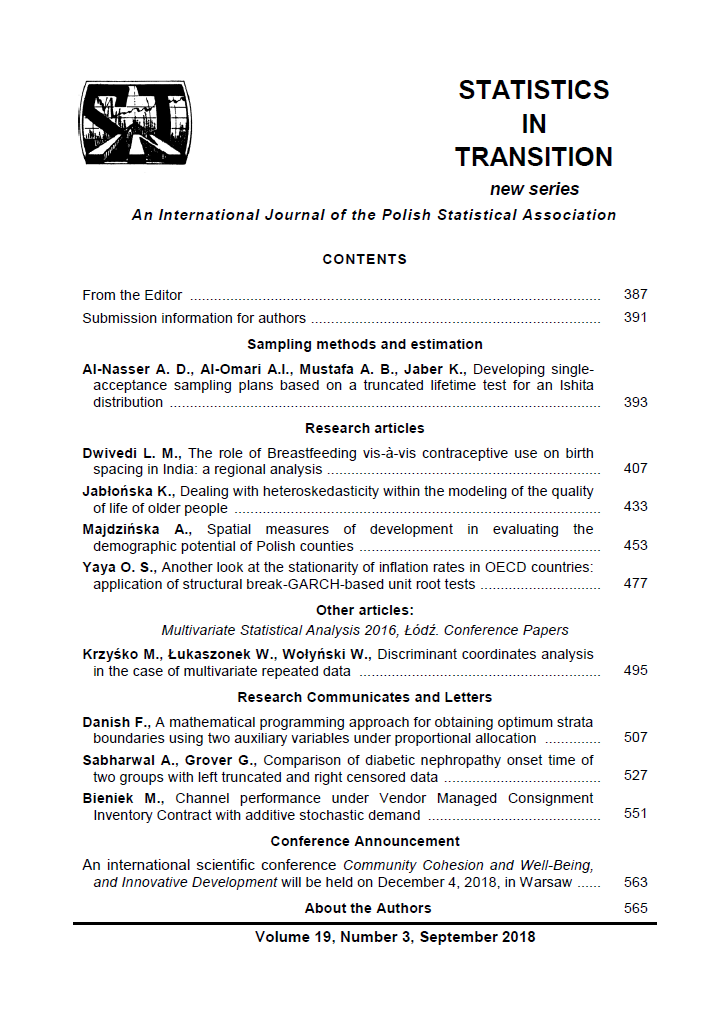ARTICLE
ABSTRACT
Optimum stratification is the method of choosing the best boundaries that make the strata internally homogenous. Many authors have attempted to determine the optimum strata boundaries (OSB) when a study variable is itself a stratification variable. However, in many practical situations fetching information regarding the study variable is either difficult or sometimes not available. In such situations we find help in the variable (s) closely related to the study variable. Using auxiliary information many authors have formulated the problem as a MPP by redefining the problem as the problem of optimum strata width, and developed a solution procedure using dynamic programming technique. By using many distributions they worked out the optimum strata boundary points for the population under different allocation. In this paper, under proportional allocation OSBs are determined for the study variable using two auxiliary variables as the basis of stratification with uniform, right-triangular, exponential and lognormal frequency distribution by formulating the problems which are executed by using dynamic programming. Empirical studies are presented to illustrate the computation details of the solution procedure and its comparison with the existing literature.
KEYWORDS
optimum stratification, multistage decision problem, mathematical programming problem. Mathematical Classification: 62D05
REFERENCES
AOYAMA, H., (1954). A study of stratified random sampling. Annals of Institute of Statistical Mathematrica, Vol. 6, pp. 1–36.
BUHLER, W., DEUTLER, T., (1975). Optimal stratification and grouping by dynamic programming. Metrik, Vol. 22, pp. 161-175.
DALENIUS, T., (1950). The problem of optimum stratification. Skandinavisk Aktuarietidskrift, Vol. 33, pp. 203–213.
DALENIUS, T., HODGES, J. L., (1959). Minimum variance stratification. Journal of American Statistical Association, Vol. 54, pp. 88-101.
DALENIUS, T. AND GURNEY, M. (1951). The problem of optimum stratification II. Skandinavisk Aktuarietidskrift, Vol. 34, pp. 133–148.
DANISH, F., RIZVI, S. E. H., SHARMA, M. K., JEELANI, M. I., (2017a). Optimum Stratification Using Mathematical Programming Approach: A Review. Journal of Statistics Applications & Probability Letters, Vol. 4(3), pp. 123–129
DANISH, F., RIZVI, S. E. H., JEELANI, M. I., REASHI, J. A., (2017b). Obtaining Strata Boundaries under Proportional Allocation with Varying Cost of Every Unit. Pakistan Journal Of Statistics and Operations Research, Vol. 13(3), pp. 567–574
KHAN, E. A., KHAN, M. G. M., AHSAN, M. J., (2002). Optimum stratification: a mathematical programming approach. Calcutta Statistical Association bulletin, Vol. 52, pp. 323–333.
KHAN, M. G. M., NAND, N., AHMAD, N., (2008). Determining the optimum strata boundary points using dynamic programming. Survey Methodology, Vol. 34 (2), pp. 205–214.
KHAN, M. G. M., NAJMUSSEHAR, AHSAN, M. J., (2005). Optimum stratification for exponential study variable under Neyman allocation. Journal of the Indian Society of Agricultural Statistics, Vol. 59 (2), pp. 146–150.
MAHALANOBIS, P. C., (1952). Some aspect of design of sample surveys.Sankhya, Vol. 12, pp. 1–17.
SINGH, R., SUKHATME, B. V., (1969). Optimum stratification. Annals of Institute of Statistical Mathematrica, Vol. 21, pp. 515–528.
SINGH, R., SUKHATME, B. V., (1973). Optimum stratification with ratio and regression methods of estimation. Annals of Institute of Statistical Mathematrica, Vol. 25, pp. 627–633.
SINGH, R., (1977). A note on equal allocation with ratio and regression methods of estimation. Australian Journal of Statistics, Vol. 19, pp. 96–104.
THOMSEN, I., (1976). A comparison of approximately optimal stratification given proportional allocation with other methods of stratification and allocation.Metrika, Vol. 23, pp. 15–25.
